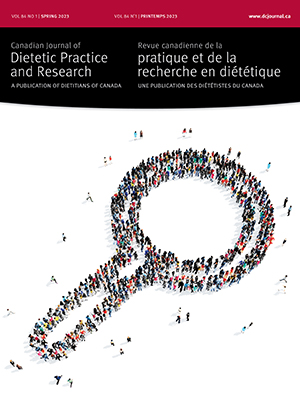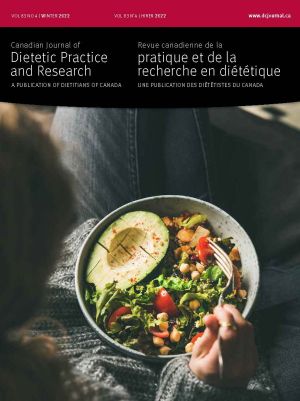Volume 63 • Number 2 • July 2002
Chair’s Message
Letters to the Editor
Review
This paper summarizes existing evidence on the impact of food information programs. Published and unpublished literature produced within the past decade was searched and reviewed. Relevant data were tabulated and key findings summarized. Food information programs are becoming increasingly popular as tools to help consumers select a healthy diet. The key feature of a food information program is a package logo on foods meeting nutrition criteria set by the program's administering body. The logo acts as a health message. Several countries, including Canada, have adopted food information programs. Critics believe that these programs oversimplify the concept of healthy eating, that consumers misinterpret the logo's meaning, that licensing fees prohibit small companies from participating, and that the programs are limited to purchase behaviour and do not necessarily have an impact on dietary intake. Consumers report support for the programs and are able to interpret a logo's meaning accurately. In addition, evidence shows the programs have had a positive impact on the nutrient composition of foods. Research is still needed, however, to establish the impact of such programs on food purchases and dietary intake, and the overall and long-term effectiveness of the programs as a nutrition intervention.
Research
L'objectif de l’étude est de tracer un portrait des pratiques Internet des diététistes du Québec, de leurs besoins à l’égard d'Internet et de vérifier si ceux-ci varient en fonction des champs d'activités. Un questionnaire a été posté à 1852 diététistes et 708 ont retourné le questionnaire. La majorité ont un ordinateur à la maison ou au travail, et ont accès à Internet. Le lieu principal d'utilisation d'Internet est le domicile. Les obstacles à une plus grande utilisation d'Internet sont le temps, les connaissances et le coût. Les services les plus utilisés sont le courrier électronique suivi du World Wide Web. La majorité serait intéressée à des programmes de formation sur la recherche à l'aide de bases de données, sur la recherche d'information dans Internet et sur l’évaluation de la fiabilité de l'information trouvée. L'analyse des données par champs de pratique a permis de déceler des pratiques et des besoins particuliers pour les diététistes en nutrition clinique, en clinique privée, en nutrition communautaire et, enfin, pour ceux cumulant des activités de clinique et de gestion. Ces résultats font ressortir la nécessité d'adapter les programmes de formation et les services à offrir selon les champs de pratique.
Traditional Indian diets are high in grains, vegetables and fruits, and in this respect are substantially in accord with Canada’s Food Guide to Healthy Eating. Adopting North American eating patterns carries potential health risks. In this study we explored migration-associated changes in eating patterns, lifestyle practices, and health-related issues of Indian immigrants and their families in Newfoundland. A cross-sectional survey employing a self-administered mailed questionnaire was conducted. A random sample of 132 subjects aged ten to 65+ took part. Participants were well established in Newfoundland and almost all were fluent in English. They were somewhat acculturated to foods commonly eaten in Canada. The majority reported that they were very or somewhat likely to engage in healthy lifestyle practices, and most (73%) wanted more relevant nutrition information. Consumption of grains, vegetables, and fruits was not in accordance with Canada’s Food Guide to Healthy Eating. Sixty-five percent of participants reported that traditional Indian foods were not readily available, and 72% indicated a change in food-preparation methods. Studies of diverse ethnic groups are needed to guide effective nutrition education programs. University curricula and dietetic training programs should include cross-cultural courses to increase awareness of immigrants’ unique needs.
Perspectives in Practice
Parkinson’s Disease (PD) is a chronic, progressive, neurodegenerative disease. People with PD are particularly susceptible to weight loss and malnutrition. Involuntary movements associated with PD result in increased energy expenditure, while both disease symptoms and medication side-effects can limit food intake. In addition, patients with the disease may choose to follow unconventional nutritional therapies that exacerbate malnutrition. Dietitians play a key role in helping patients with PD to optimize their nutritional status and manage various nutritionrelated symptoms and medication side-effects. To assume this role, dietitians need to have current knowledge about PD and its nutritional consequences, as well as strategies for managing a variety of nutrition-related symptoms.










